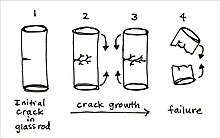Static fatigue
It has been suggested that this article be merged into Fatigue (material). (Discuss) Proposed since August 2024. |
Static fatigue, sometimes referred to as delayed fracture, describes the progressive cracking and eventual failure of materials under a constant, sustained stress.[1] (It is different from fatigue, which refers to the deformation and eventual failure of materials subjected to cyclical stresses.) With static fatigue materials experience damage or failure under stress levels that are lower than their normal ultimate tensile strengths.[2] The exact details vary with the material type and environmental factors, such as moisture presence[3] and temperature.[4][5] This phenomenon is closely related to stress corrosion cracking.[1]
Typical occurrence

Stress corrosion cracking
Stress corrosion cracking (SCC) happens when a stressed material is in a corrosive (chemically destructive) environment.[6] One example of SSC embrittlement is when moisture increases static fatigue degradation of glass.[7] SCC is also seen in hydrogen embrittlement[8][9] and embrittlement of some polymers.[10]
Plastic Deformation (Plastic Flow)
Plastic deformation happens when stresses flatten, bend, or twist a material until it cannot return to its original shape.[11] This can create cracks in the material and decrease its lifetime.[12]
Testing
Static fatigue tests can be used to determine the lifespan of a material with different loads and environmental conditions.[13][14] However, accurately assessing a material's true static fatigue life presents challenges, as these tests often require an extended duration and there is significant variability in the results.[13]
Examples of Static Fatigue and Stresses on Materials
Plastic pipes under water or other fluids experience hydrodynamic forces that can result in fatigue.[15] The pipes reach failure sooner as temperatures and exposure to aggressive substances increase.[15]
References
- ^ a b Suresh, S. (1998). Fatigue of materials (2nd ed.). Cambridge; New York: Cambridge University Press. ISBN 978-0-521-57046-6.
- ^ Pelleg, Josh (2021). Cyclic Deformation in Oxides, Carbides, and Nitrides. Vol. 22. Springer. pp. 495–511. doi:10.1007/978-3-030-86118-6_15. ISBN 978-3-030-86118-6. S2CID 244421914.
- ^ Laughton, M.J.; Warne, D.J.; Tricker, R. (2003). Optical Fibres in Power Systems (16 ed.). Newnes. pp. 37–1, 37-3 – 37-17. doi:10.1016/B978-075064637-6/50037-X. ISBN 978-0-7506-4637-6.
- ^ Kingery, W.D. (1976). Introduction to ceramics. New York: Wiley. ISBN 978-0471478607.
- ^ Ebel, A.; Caty, O.; Rebillat, F. (2022). "Effect of temperature on static fatigue behavior of self-healing CMC in humid air". Composites Part A: Applied Science and Manufacturing. 157: 106899. doi:10.1016/j.compositesa.2022.106899. S2CID 247148726.
- ^ Raja, V.S.; Tetsuo, Shoji (2011). Stress Corrosion Cracking. Woodhead Publishing. pp. 245–272. doi:10.1533/9780857093769.3.245. ISBN 978-1-84569-673-3.
- ^ Wiederhorn, S. M.; Bolz, L. H. (1970-10-01). "Stress Corrosion and Static Fatigue of Glass". Journal of the American Ceramic Society. 53 (10): 543–548. doi:10.1111/j.1151-2916.1970.tb15962.x. ISSN 1551-2916.
- ^ Lou than, M.R. "Hydrogen Embrittlement - Office of Scientific and Technical Information" (PDF).
- ^ Murakami, Y.; Kanezaki, T.; Matsuoka, S. (2008). "Hydrogen Embrittlement Mechanism in Fatigue of Austenitic Stainless Steels". Metallurgical and Materials Transactions A. 39 (6): 1327–1339. Bibcode:2008MMTA...39.1327M. doi:10.1007/s11661-008-9506-5. S2CID 137234625.
- ^ Brown, Norman; Parrish, Mark F. (1974). Bishay, Adli (ed.). Recent Advances in Science and Technology of Materials. Springer US. pp. 1–13. doi:10.1007/978-1-4613-4538-1_1. ISBN 9781461345404.
- ^ Pfeifer, Michael (2009). "Chapter 6 - Degradation and Reliability of Materials". Materials Enabled Designs. Butterworth Heinemann. pp. 161–187. doi:10.1016/B978-0-7506-8287-9.00006-9. ISBN 978-0-7506-8287-9 – via Science Direct.
- ^ Wang, G.S.; Blom, A.F. "Effect of Large Local Plastic Flow on the Fatigue Life of Metallic Materials". Aeronautics Division – via The Swedish Defence Research Agency.
- ^ a b Wilkins, B.J.; Dutton, R. (March 1976). "Static Fatigue Limit with Particular Reference to Glass". Journal of the American Ceramic Society. 59 (3–4): 108–112. doi:10.1111/j.1151-2916.1976.tb09442.x.
- ^ Kelly, A.; Zweben, C.; Sims, G.D.; Broughton, W.R. (2000). Comprehensive Composite Materials (2.05 - Glass Fiber Reinforced Plastics—Properties). Vol. 2. Pergamon. pp. 151–197. doi:10.1016/B0-08-042993-9/00181-9. ISBN 978-0-08-042993-9.
- ^ a b Farshad, Mehdi (2006-01-01), Farshad, Mehdi (ed.), "7 - Fatigue, corrosion, and wear", Plastic Pipe Systems, Oxford: Elsevier Science, pp. 153–165, ISBN 978-1-85617-496-1, retrieved 2023-04-15